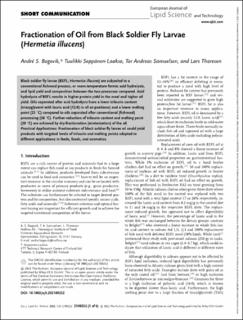| dc.contributor.author | Bogevik, André Sture | |
| dc.contributor.author | Seppänen-Laakso, Tuulikki | |
| dc.contributor.author | Samuelsen, Tor Andreas | |
| dc.contributor.author | Thoresen, Lars | |
| dc.date.accessioned | 2023-02-08T13:46:50Z | |
| dc.date.available | 2023-02-08T13:46:50Z | |
| dc.date.created | 2022-05-23T12:52:30Z | |
| dc.date.issued | 2022 | |
| dc.identifier.citation | European Journal of Lipid Science and Technology. 2022, 124 (5), 1-6. | |
| dc.identifier.issn | 1438-7697 | |
| dc.identifier.uri | https://hdl.handle.net/11250/3049377 | |
| dc.description.abstract | Black soldier fly larvae (BSFL; Hermetia illucens) are subjected to a conventional fishmeal process, or room-temperature formic acid hydrolysis, and lipid yield and composition between the two processes compared. Acid hydrolysis of BSFL results in higher protein yield in the meal and higher oil yield. Oils separated after acid hydrolysis have a lower trilaurin content (triacyglycerol with lauric acid (12:0) in all sn-positions) and a lower melting point (23 °C) compared to oils separated after conventional (fishmeal) processing (26 °C). Further reduction of trilaurin content and melting point (20 °C) are achieved by dry-fractionation (winterization) of the oil. Practical Applications: Fractionation of black soldier fly larvae oil could yield products with targeted levels of trilaurin and melting points adapted to different applications in feeds, foods, and cosmetics. | |
| dc.language.iso | eng | |
| dc.title | Fractionation of Oil from Black Soldier Fly Larvae (Hermetia illucens) | |
| dc.title.alternative | Fractionation of Oil from Black Soldier Fly Larvae (Hermetia illucens) | |
| dc.type | Peer reviewed | |
| dc.type | Journal article | |
| dc.description.version | publishedVersion | |
| dc.source.pagenumber | 1-6 | |
| dc.source.volume | 124 | |
| dc.source.journal | European Journal of Lipid Science and Technology | |
| dc.source.issue | 5 | |
| dc.identifier.doi | 10.1002/ejlt.202100252 | |
| dc.identifier.cristin | 2026506 | |
| cristin.ispublished | true | |
| cristin.fulltext | original | |
| cristin.qualitycode | 1 | |
